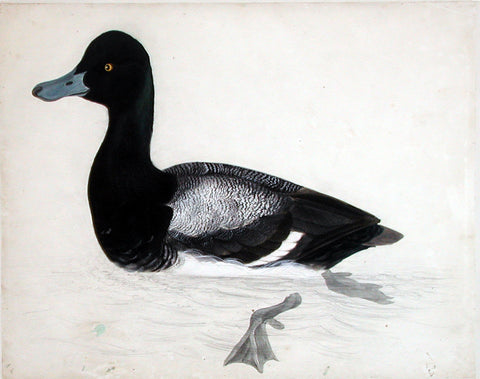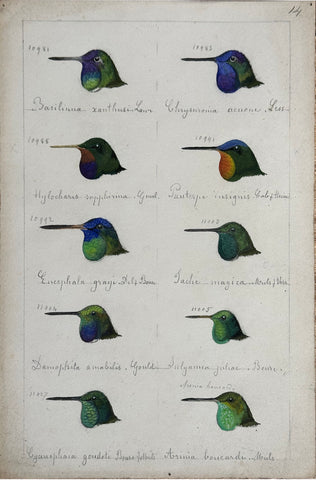
ROBERT MITFORD (BRITISH, 1781-1870), “Scaup Duck, male” (Scaup Pochard, male)
ROBERT MITFORD (BRITISH, 1781-1870)
“Scaup Duck, male” (Scaup Pochard, male)
Preparatory work for Prideaux John Selby’s Plate 66 of Illustrations of British Ornithology
Watercolor, gouache, grey and brown washes, pen and black ink on paper
Signed lower left.: RM
London, ca. 1820
Paper size: 14 3/8 x 18 1/4 in.
PLATE 66. represents the Adult Male of the natural size. General Head and upper part of the neck blackish-green, with rich glossy reflections. Lower part of neck, breast, and rump deep black. Mantle and scapulars greyish-white, with fine distant zigzag black lines. Lesser wing coverts black, with transverse zigzag white lines. Secondary quills white, with black tips, forming a bar or speculum across the wings. Belly and flanks white. Abdomen rayed with lines of blackish-grey. Bill clear greyish-blue, broad and spathulate, with the nail black. Irides king yellow. Legs and toes bluish-grey, the joints and webs being darker.
PLATE 66. Female. In the female (formerly supposed a distinct species, under the title of Anas frcenata the bill is of a deep-grey colour, with the nail black. Around the base of the bill is a broad band of white. The rest of the head and the upper part of the neck are deep umber-brown, glossed on the sides with green. Lower part of the neck and breast having the basal part of the feathers broccoli-brown; the tips of the former being deeply margined with clear yellowish-brown, and those of the breast with white. Belly and abdomen white. Sides, flanks, and vent hair-brown, marbled with zigzag lines of white and darker brown. Mantle and scapulars brownish-black, finely mottled with zigzag lines of white. Tertials black, tinged with olive-green. Speculum as in the male bird. Quills and tail blackish-brown, with a glossy lustre. The young males re- Young, semble the adult females till after the first general moult. In the young females the colours are less distinct, and the back is nearly destitute of the zigzag black and white lines.”
Considered by many as the English equivalent of Audubon, Prideaux John Selby created some of the most memorable bird images of the nineteenth-century. His contributions to British ornithology were rivaled only by those of John Gould. Yet, his pictures were larger and less purely scientific, exhibiting Selby’s distinctive and charming style. A sense of Selby’s enthusiasm for his subjects is nowhere more palpable than in his engaging original watercolors. Selby executed these delightful images as preparatory models for his landmark printed series, Illustrations of British Ornithology. While the artist’s engraved work is highly desirable to collectors, Selby’s original watercolors rarely become available. This selection of watercolors, moreover, comprises several of his masterpieces. The distinctive birds are depicted in profile, their forms delineated by softly modulated tones of black and gray wash. The setting, if present, is lightly but skillfully painted to not distract from the birds themselves. The skill and delicacy of Selby’s touch, his keen powers of observation, and his artistic sensitivity are conveyed here in a way they are not in his printed work. Several of the drawings are by Selby’s brother-in-law, Robert Mitford, but signed in Selby’s hand.
Born in Northumberland and educated at University College, Oxford, Selby was a landowner and squire with ample time to devote to studying the plant and animal life at his country estate, Twizell House. As a boy, he had studied the habits of local birds, drawn them, and learned how to preserve and set up specimens. Later, Selby became an active member of several British natural history societies and contributed many articles to their journals. Although Selby was interested in botany and produced a History of British Trees in 1842, he is best known for his Illustrations of British Ornithology. Selby’s work was the first attempt to create a set of life-sized illustrations of British birds, remarkable for their naturalism and the delicacy of their execution. The British Ornithology was issued in nineteen parts over thirteen years; the book consisted of 89 plates of land birds and 129 plates of water birds, engraved by William Lizars of Edinburgh, the printer who engraved the first ten plates of Audubon’s Birds of America.
With their rich detail and tonal range, these exquisite watercolors are beautiful works by one of the foremost British bird painters. Furthermore, they represent a singular opportunity to obtain a unique piece of the highest quality by this luminary artist, from an era in British ornithological art that remains unparalleled.
or by email at loricohen@aradergalleries.
We Also Recommend





